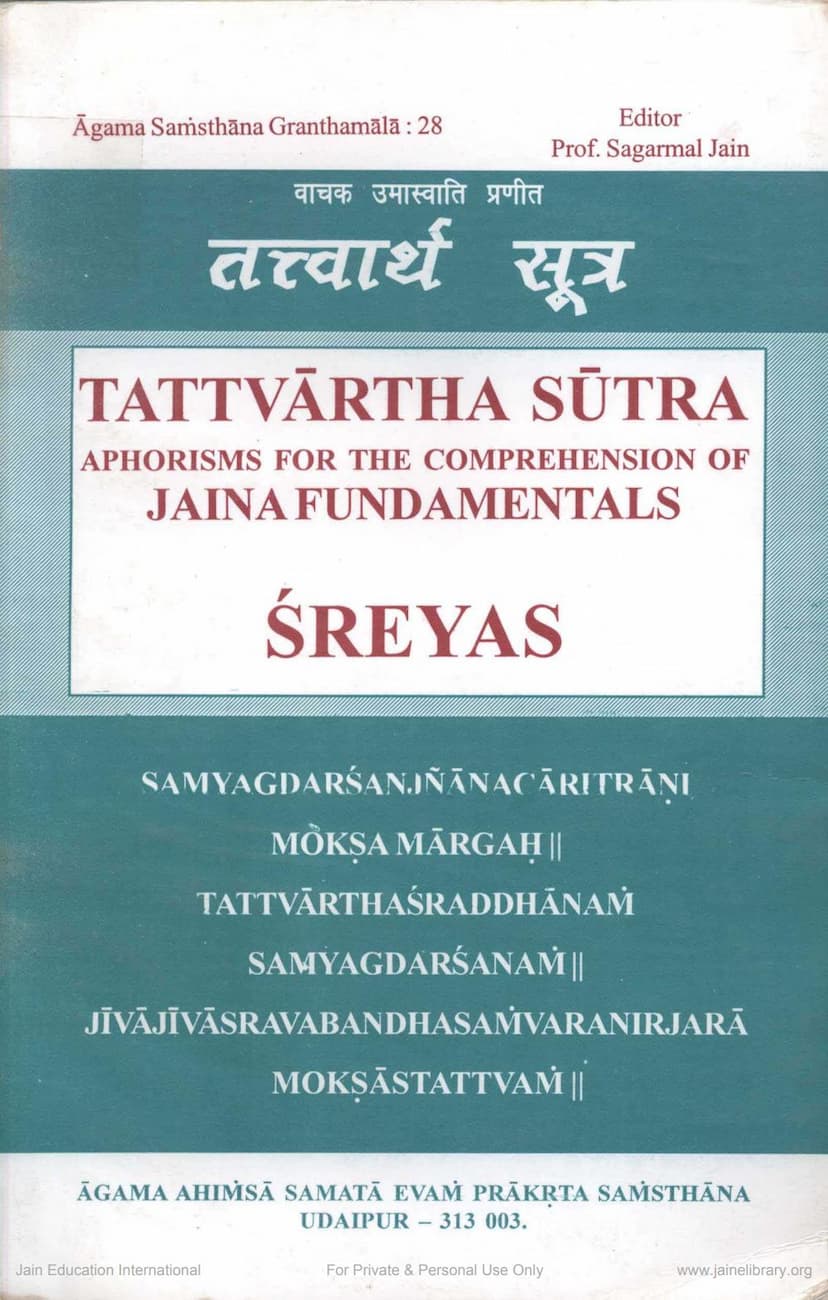Tattvartha Sutra
Added to library: September 2, 2025

Summary
Here's a comprehensive summary of the Tattvartha Sutra, based on the provided text, focusing on its core teachings and structure:
The Tattvartha Sutra, authored by Vācaka Umāsvāti (also known as Umāsvami and Grddhapiccha), is a foundational Jain text that meticulously outlines the fundamental principles of Jainism. It is uniquely accepted by both the Svetambara and Digambara traditions, making it a significant authoritative scripture for all Jains. The book is presented here in a bilingual edition, with English transliteration, translation, and explanation, making it accessible to a wider audience.
Core Philosophy and Structure:
The Tattvartha Sutra is structured into ten chapters, each delving into specific aspects of Jain philosophy. The author's aim was to compile scattered Jain fundamentals into a concise, accessible, and authoritative work. The text is written in the sutra style, characterized by brief aphorisms, a style that Umāsvāti pioneered in Jain scriptural literature, drawing inspiration from the concise Sanskrit aphorisms of other contemporary philosophical traditions.
Key Concepts and Chapters:
The text is broadly divided into three main analyses:
- Jñana Mimamsa (Analysis of Knowledge): Covered in Chapter 1.
- Jñeya Mimamsa (Analysis of the Knowable): Covered in Chapters 2 through 5.
- Caritra Mimamsa (Analysis of Conduct): Covered in Chapters 6 through 10.
Chapter-wise Summary:
-
Chapter 1: The Liberating Path (Moksha Marga):
- Defines the path to liberation as the combination of Right View (Samyagdarshana), Right Knowledge (Samyagjnana), and Right Conduct (Samyakcharitra).
- Explains that Right View is having firm faith in the fundamental verities.
- Categorizes knowledge into five types: Mati (sensory), Shruta (scriptural), Avadhi (clairvoyant), Manahparyaya (telepathic), and Kevala (omniscience). It distinguishes between direct (Pratyaksha) and indirect (Paroksha) knowledge.
- Introduces the concept of Nayas (standpoints) as tools for understanding reality.
-
Chapter 2: Living Beings (Jiva-Tattva):
- Focuses on the soul (Jiva) as a fundamental entity characterized by consciousness (Upayoga).
- Classifies souls into two main categories: Samsari (worldly) and Mukta (liberated).
- Discusses the various states of worldly beings, including their sensory organs, bodies (gross to karmic), gender, and life-spans.
- Explains the concept of bhavas (volitional dispositions) and their classifications.
-
Chapter 3: Nether and Middle Worlds (Adho and Madhya Loka):
- Describes the cosmology of Jainism, detailing the seven hellish grounds (Adholoka) and the inhabitants thereof.
- Explains the structure of the Middle World (Madhyaloka), including its continents, oceans, mountains, and the regions inhabited by humans and sub-human beings (Tiryañca).
-
Chapter 4: The Heavens (Urdhva Loka):
- Details the various heavens (Vaimānika, Bhavana, Vyantara, Jyotiska) and the celestial beings (Devas) residing in them.
- Describes their life-spans, powers, and the hierarchical structure within the heavens.
- Discusses the different types of gods based on their location and spiritual development.
-
Chapter 5: Inanimate Matter (Ajiva-Tattva):
- Explains the existence of four types of inanimate matter (Ajiva): Dharmastikaya (medium of motion), Adharmastikaya (medium of rest), Akāśastikaya (space), and Pudgalastikaya (tangible matter).
- These are described as eternal, immutable, and mostly formless, except for Pudgala.
- Discusses the spatial extent and functions of these substances.
- Explains the concept of reality (Sat) as that which undergoes origination, decay, and continuity, and the manifold nature of reality (Anekanta).
-
Chapter 6: The Influx (Asrava-Tattva):
- Defines Asrava as the influx of karma particles into the soul due to activities of body, speech, and mind (Yoga).
- Distinguishes between pious influx (Punya) and impious influx (Papa) based on the nature of Yoga.
- Details the specific causes of influx for different types of karma, such as knowledge-obscuring, vision-obscuring, feeling-producing, deluding, lifespan-determining, physique-determining, status-determining, and obstruction-causing karmas.
-
Chapter 7: Vows and Charity (Vrata and Dana):
- Defines vows (Vrata) as refraining from violence, untruth, theft, sexual indulgence, and excessive attachment to possessions.
- Distinguishes between minor vows (Anuvrata) and great vows (Mahavrata) based on the degree of renunciation.
- Outlines the supporting principles (Bhavana) for observing vows.
- Explains the concept of "vowers" (Vrati) and their types (householders and ascetics).
- Details the flaws (Atichara) associated with each vow.
- Defines charity (Dana) as the act of giving for the welfare of others.
-
Chapter 8: The Bondage (Bandha-Tattva):
- Explains that bondage occurs when the soul, due to passions, attracts and binds karma particles.
- Identifies the causes of bondage as false view, lack of restraint, negligence, passions, and activities.
- Categorizes bondage into four types: Prakriti (nature), Sthiti (duration), Anubhava (intensity), and Pradesha (quantity).
- Details the various sub-categories of karmas and their respective durations of bondage.
-
Chapter 9: Stoppage and Separation (Samvara and Nirjara):
- Defines Samvara as the stoppage of influx of new karma particles.
- Identifies the means of Samvara as restraint (Gupti), vigilance (Samiti), contemplation (Anupreksha), endurance of hardships (Parishaha Jaya), and righteous conduct (Charitra).
- Defines Nirjara as the shedding or separation of already bonded karma.
- States that penance (Tapa) leads to both Samvara and Nirjara.
- Details the types of penance (external and internal), meditations (Ārtha, Raudra, Dharma, Shukla), and stages of spiritual development that contribute to Nirjara.
- Explains the classification of ascetics (Nirgrantha) based on their spiritual progress.
-
Chapter 10: Liberation (Moksha-Tattva):
- Defines liberation as the complete destruction of all karma from the soul.
- States that omniscience (Kevala) is attained by the destruction of deluding, knowledge-obscuring, vision-obscuring, and obstruction-causing karmas.
- Explains that after liberation, the soul moves upwards to the apex of the universe (Siddhashila).
- Describes the characteristics of the liberated soul (Siddha).
The Tattvartha Sutra serves as a comprehensive guide to the Jain path, systematically explaining its metaphysical principles, ethical guidelines, and the ultimate goal of spiritual liberation. Colonel D.S. Baya's translation and commentary aim to make this profound text comprehensible to a lay readership, bridging the gap between scholarly works and accessible spiritual learning.